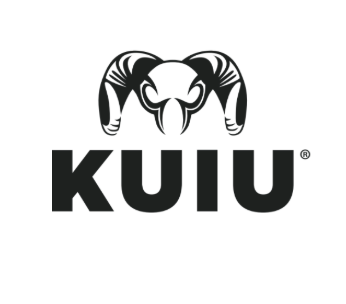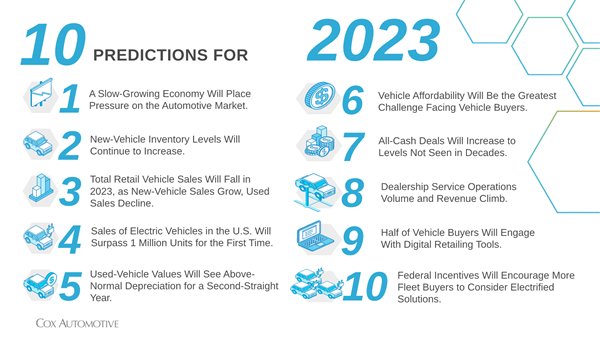Cox Automotive's 10 Predictions for 2023
01/09/2023
The Cox Automotive Industry Insights team has offered its expectations for the U.S. automotive market in 2023. By nearly all measures, 2022 was a difficult year for both the industry and the consumer, marked by historically low new-vehicle inventories, high prices, and stubborn inflation chipping away at monthly budgets. A relatively strong jobs market was a tailwind, but all the while, a hawkish Federal Reserve pushed rates higher, essentially riding the brakes as the auto industry struggled to gain momentum.
“This past year was challenging not only to forecast but for the industry to manage,” said Cox Automotive Chief Economist Jonathan Smoke. “As we look forward into 2023, we see one set of challenges being replaced by another. We expect the year ahead to be one of transition, as both the consumer and the industry move past the remnants of a global pandemic and set a new course for mid-decade growth.”
Guided by recent research, intelligence capabilities powered by DRiVEQ, the largest breadth of first-party data in the automotive ecosystem, and an unmatched team of analysts and experts, Cox Automotive posits 10 trends that will shape the auto business in 2023.
#1: A Slow-Growing Economy Will Place Pressure on the Automotive Market.
While the risk of recession in 2023 remains, Cox Automotive expects the economy to see at least slowing or very weak growth as the Federal Reserve tightens monetary conditions and consumers continue to wrestle with high interest rates. A job-wrecking recession is a worst-case scenario for the auto industry, but hope for an economic soft landing remains. Either way, a sputtering economy will hold back the auto market in the year ahead.
#2 New-Vehicle Inventory Levels Will Continue to Increase.
New-vehicle production challenges are beginning to ebb, and inventory levels are measurably improving. While lingering supply chain and labor challenges will remain, and capacity will not return completely to pre-pandemic levels in the foreseeable future, stronger production levels and softer demand will lead to higher days’ supply and, ultimately, more vehicle options for shoppers in 2023.
#3: Total Retail Vehicle Sales Will Fall in 2023, as New-Vehicle Sales Grow, Used Sales Decline.
With new-vehicle inventory levels improving as demand slows, Cox Automotive forecasts 3% year-over-year new-vehicle sales growth in 2023, with the market hitting 14.1 million units. Increasing fleet sales will help the absolute number. A lack of nearly new supply, declining affordability, and a shrinking pool of buyers will challenge the used-vehicle market. Overall retail sales will decline in 2023, adding competitive pressures to the market, especially in used.
#4: Sales of Electric Vehicles in the U.S. Will Surpass 1 Million Units for the First Time.
The battery-electric vehicle market continues to outpace the overall market in sales, and a new milestone is on the horizon: 1 million EVs sold in the U.S. in 2023. With expanded product availability coming and a fresh round of government-backed incentives to motivate buyers, the Cox Automotive team is forecasting continued good news in the electrified vehicle market.
#5: Used-Vehicle Values Will See Above-Normal Depreciation for a Second-Straight Year.
What the market gives, the market takes: After historic value increases in 2020 and 2021, followed by above-average depreciation for most of 2022, used-vehicle values are likely to see another year of above-normal depreciation, especially in the first half of 2023. Price trends should normalize in the second half of the year as constrained wholesale supply supports used values and used retail prices fall into a normal relationship with new prices.
#6: Vehicle Affordability Will Be the Greatest Challenge Facing Vehicle Buyers.
Elevated retail prices and high auto loan interest rates combined to produce record monthly payments in 2022, levels that increasingly pushed lower income and lower credit quality consumers out of the market. More of the same is expected in 2023, as the automakers increasingly cater to the new-vehicle market with more expensive products for higher-income consumers, leaving less-affluent and subprime buyers struggling to find affordable vehicle payments that satisfy monthly budgets.
#7: All-Cash Deals Will Increase to Levels Not Seen in Decades.
With auto loan interest rates hitting 20-year highs, the rise in all-cash deals will continue. More wealthy consumers will buy with cash rather than finance in 2023, placing downward pressure on dealership F&I profits. This change will be felt more acutely in the new-vehicle market and will likely have lingering impacts on industry profit pools and future buying behaviors.
#8: Dealership Service Operations Volume and Revenue Climb.
As affordability issues lead more owners to maintain current vehicles, 2023 should see continued strong dynamics in the service lanes, with or without a recession. Fixed operations saw strong revenue growth in 2022 as pricing power and strong demand led to large increases in average ticket size despite total service volumes not yet recovering to 2019 levels. With retail sales expected to be flat or down, fixed operations as a profit center will be more important than ever in 2023.
#9: Half of Vehicle Buyers Will Engage With Digital Retailing Tools.
The shift to eCommerce was accelerated by the pandemic and shows no sign of fading. In the year ahead, Cox Automotive forecasts that half of all vehicle buyers will engage with at least one digital tool during the purchase process. Importantly, fully digital vehicle purchases will continue to be only a small percentage of the business, as most buyers will pursue an omnichannel vehicle buying experience.
#10: Federal Incentives Will Encourage More Fleet Buyers to Consider Electrified Solutions.
A key element of the Inflation Reduction Act of 2022 was the reshaping of EV tax credits in the U.S. Within the new laws are incentives designed to entice fleet operators to consider electrified vehicles in the coming year. Fleets have historically shown slow adoption of EVs, but recent research indicates 66% of fleet buyers are considering EVs, up from 43% in 2021. New incentives and investments in charging infrastructure will likely amplify the trend.
SHARE THIS NEWS
Read more like this

Cox Enterprises
Cox Enterprises Launches New Cox Outdoors Business Segment
12/09/2025
Cox Outdoors unites the company’s recent investments in...

Cox Enterprises
KUIU Ultralight Hunting Acquired by a Collective of Conservation-Minded Families
12/08/2025
This acquisition will bolster KUIU’s commitment to its customers, employees and innovation.

Cox Enterprises
From Ideas to Impact: Cox Cleantech Accelerator Startups Deliver Cutting-Edge Climate Solutions at Atlanta Showcase
11/03/2025
Cox Enterprises, gener8tor and the Georgia Cleantech Innovation Hub hosted the inaugural Cox Cleantech...
